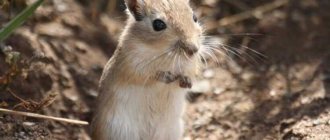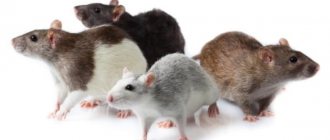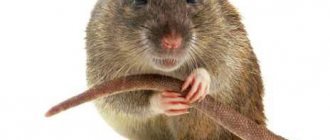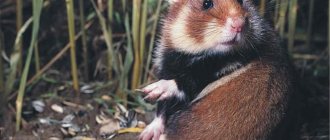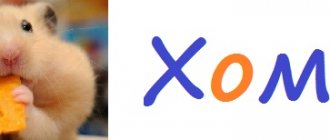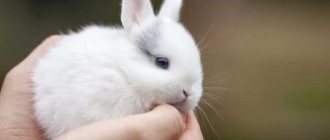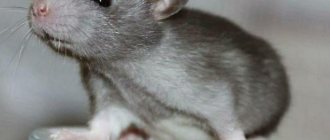Review author: “ZooVita”
At first glance, this mysterious animal from the order of rodents evokes tenderness and keen interest. These furry animals are so small that they fit completely into the palm of an adult. You can recognize a dormouse by its long and fluffy tail, as well as by its specific fur color.
Photos of forest dormouse can be found on the pages of reference books of fauna and wildlife representatives.
Description of the rodent
— Advertising —
Externally, dormice resemble mice or squirrels. Their body length is 8-20 cm. The tail is from 4 to 17 cm long, densely pubescent in most species, only in selevinia and mouse-like dormouse it is half naked. The ears are round in shape, without tufts. The paws are short, with well-developed sharp claws. The fur is thick and soft. The back is colored from gray to ocher-brown.
Social structure and reproduction
Photo: Animal forest dormouse
Dormice of different sexes stay together for a very short period of life. In the spring they begin mating games. Males wake up from hibernation earlier than females and begin to mark trees. They eat intensely to regain strength after a long sleep. After about a week, the females also emerge from their burrows. At night they make loud whistles, “singing” sounds and leave their marks near the marks of males.
During the breeding season they live in pairs in the same nest. But just before giving birth, the female forcibly expels the male. Her pregnancy lasts about 28 days. After their completion, up to 8 cubs are born. Basically, the offspring is 1 time per year. On the eve of childbirth, the female becomes especially economical and constantly repairs and insulates the shelter. With a large amount of food, dormice can even live in families in one nest.
Little dormouse are born naked and blind and weigh about 2 g in the first day. A caring mother is always with the offspring, feeds and warms the children, going out briefly to feed and closing the nesting hole. If one of the babies is missing, the mother finds him by squeaking and brings him back.
At the age of 2 weeks, the cubs' eyes fully open and soon they will be able to independently climb tree branches and find food for themselves. At the age of 45 days they become independent and leave the nest.
Sony's nutritional features
Dormice feed on both plant and animal foods. Seeds and fruits of trees and shrubs (acorns, linden nuts, beech nuts, apples) are consumed as plant foods. Among animal foods, they prefer insects; they eat eggs and small chicks less often. The composition of the diet for each species is closely related to the season and habitat.
Habitat of the forest dormouse
You can meet the dormouse in Asia, a number of European countries, and in some regions of Russia. Basically, the distribution area is associated with the rodent’s adherence to a temperate climate.
Sonya prefers to settle mainly in deciduous forests, where there are a large number of oak trees, dense bushes, and multi-tiered green spaces. Furry forest dwellers build shelters in old hollows, bird nests, and in large crevices between the bark and tree trunk.
Thickets of bushes, the branches of which have sharp thorns and thorns, often provide reliable protection against natural enemies. These animals can build their own nests, using bark, branches, leaves, down, and bird feathers as building materials.
Common types of dormouse
There are many types of dormouse, but outwardly they look almost the same and differ, first of all, in the region of their habitat.
Angolan Dormouse (Graphiurus angolensis)
The species is endemic to Angola, where it lives in tropical and subtropical dry forests.
Sonya Christy (Graphiurus christyi)
Distributed in Cameroon and Congo. Lives in subtropical and tropical moist lowland forests.
Fat-tailed Dormouse (Graphiurus crassicaudatus)
The species' habitat includes Cameroon, Cote d'Ivoire, Ghana, Liberia, Nigeria and Togo, Guinea and Sierra Leone. Found in subtropical and tropical moist lowland forests.
Johnston's Dormouse (Graphiurus johnstoni)
It lives in the wet savannas of Malawi, Zambia and Zimbabwe.
Dormouse hueti (Graphiurus hueti)
The species is distributed in Cameroon, Ghana, Liberia, Nigeria, Sierra Leone and Gabon. Inhabits tropical and subtropical moist lowland forests.
Dormouse Kelleni (Graphiurus kelleni)
The distribution region includes tropical and subtropical dry forests, dry and wet savannas of Angola, Burkina Faso, Cameroon, Central African Republic, Congo, Gambia, Kenya, Mali, Nigeria, Niger, Senegal, Tanzania and Uganda.
West African dormouse (Graphiurus lorraineus)
Found in Cameroon, Congo, Ghana, Guinea-Bissau, Liberia, Nigeria, Sierra Leone, Tanzania, Uganda. The habitat is tropical and subtropical rainforests, savannas and plantations.
Short-eared Dormouse (Graphiurus microtis)
It lives in countries such as Angola, Botswana, Eritrea, Ethiopia, Kenya, Lesotho, Malawi, Mozambique, Namibia, South Africa, Sudan, Swaziland, Tanzania, Zambia and Zimbabwe.
Dormouse Monarda (Graphiurus monardi)
Distributed in Angola, Congo and Zambia, where it lives in humid savannas.
Savannah Dormouse (Graphiurus murinus)
The species is endemic to South Africa. It lives in subtropical or tropical rainforests, near rivers.
Spectacled or South African dormouse (Graphiurus ocularis)
The tail is fluffy, resembling a squirrel, with white hairs, the muzzle is short, the ears are small, the fur is soft. There are white and gray specks on the muzzle, and dark circles are visible around the eyes. The cheeks, belly and paws are white on top.
They live in western South Africa, in rocky areas.
Rock dormouse (Graphiurus rupicola)
Resident of Namibia, South Africa and Angola. Lives in rocky places.
Flat-headed dormouse (Graphiurus platyops)
It is found in countries such as Angola, Botswana, Mozambique, Swaziland, Zambia and Zimbabwe.
Guinea dormouse (Graphiurus surdus)
Distributed in tropical and subtropical moist lowland forests of Cameroon, Congo, Equatorial Guinea and Gabon.
Anatolian or downy dormouse (Dryomys laniger)
The species is endemic to Turkey.
Balochistan Dormouse (Dryomys niethammeri)
Found exclusively in Pakistan.
Forest dormouse (Dryomys nitedula)
Body length is up to 12 cm, tail is up to 10 cm long. Weight ranges from 30 to 40 g. The fur is grayish-ocher, changeable. For example, in the European part of Russia it becomes lighter from north to south. In Transcaucasia, the Apennines, the Alps and the Balkan Peninsula, forest dormouse are gray in color. The belly is grayish to white. The tail is fluffy, dark gray. A dark stripe runs from the nose to the ear.
The species is distributed in Europe, Transcaucasia and Asia in various types of forests.
Sichuan Dormouse (Chaetocauda sichuanensis)
Body length is about 9 cm, tail length is 9-10 cm. Weight is from 24.5 to 36.0 g.
The species was found in mixed forests in northern Sichuan, China. Since 2004, it has been included in the Red Book as a species in danger.
Black-tailed Dormouse (Eliomys melanurus)
Body length 10-18 cm, tail length 9-14 cm, weight 45-120 g. The back is brown, the belly is whitish. There is a dark “mask” over the eyes. The tail is fluffy, the tip is black.
The species is distributed from northeast Libya to the west of the Arabian Peninsula, and all the way to southern Turkey.
Garden Dormouse (Eliomys quercinus)
Body length is from 11 to 16 cm, tail length is from 9 to 14 cm, weight is 60-140 g. The muzzle is pointed. The ears are large, without tufts. The eyes are big. The fur is short, gray or brown on top, the belly is white, a black stripe runs from the eye and a little further than the ear, the tip of the fluffy tail is decorated with a white tassel.
Inhabits deciduous forests and gardens of Western Europe.
Maghreb Dormouse (Eliomys munbyanus)
It is found in Algeria, Libya, Morocco, Tunisia and Western Sahara, in humid forests and semi-deserts.
Kopetdag or mouse-like dormouse (Myomimus personatus)
Body length is about 8 cm. Tail is 5-6 cm long. The back is gray with a blurred dark stripe. The belly is white.
Lives in Turkmenistan and Iran.
Bulgarian dormouse (Myomimus roachi)
Distributed in Bulgaria, Greece and Turkey.
Iranian dormouse (Myomimus setzeri)
The species is endemic to Iran.
Selevinia (Selevinia betpakdalaensis)
Body length is about 10 cm, tail is up to 7.5 cm long, weight is about 30-35 g. The coat is thick and lush. The tail is densely covered with short hairs. The back is gray, the belly is whitish. The ears are large, the animal is able to roll them into a tube and unfold them like a fan.
A rare species, it is endemic to Kazakhstan, where it lives in deserts.
Japanese Dormouse (Glirulus japonicas)
Endemic to Japan. Distributed in temperate forests. Able to quickly run upside down and hang on branches.
Hazel Dormouse (Muscardinus avellanarius)
Body length is about 15 cm, weight is from 15 to 25 g. The tail is from 6 to 8 cm in length, with a tassel. The muzzle is blunt, the ears are small, round in shape, and the mustache is long. The back is ocher-red in color, rarely with a reddish tint, the belly is light with a fawn tint. The throat, chest and belly are light. Fingers are white. The tip of the tail is dark or light.
It is found in deciduous and mixed forests of Europe and northern Turkey.
Dormouse (Glis glis)
The largest of the dormouse, with a body length of 13 to 18 cm, weighing 150-180 g. It looks like a gray squirrel, but there are no tufts on its rounded ears. The tail is from 11 to 16 cm long, fluffy, gray above, whitish below. The fur is lush and fluffy, smoky gray or grayish-brown on the back and light gray, yellowish or white on the belly. The eye rings are dark and thin.
The habitat includes lowland and mountain forests of Europe, the Caucasus and Transcaucasia. It is found on the islands of the Mediterranean Sea: Sardinia, Corsica, Sicily, Crete and Corfu.
Population and species status
Nowadays, the forest dormouse is a rare animal, so it is listed in the Red Books of the Kursk, Oryol, Tambov and Lipetsk regions. This animal is listed on the IUCN Red List and is therefore internationally protected by the Vienna Convention.
The forest dormouse is a unique animal that is on the verge of extinction, like many other species of wildlife. It is difficult to say what factors had a decisive influence, but most likely this is due to human activity, which deprives these animals of their natural habitats, destroying forest areas for various purposes. If we add to this the unfavorable environmental situation, we get a completely depressing picture.
Forest Dormouse
Dormouse behavior
Most dormice are forest animals and are nocturnal. They also live in the forest-steppe, in the mountains at an altitude of up to 3500 m above sea level, deserts, and savannas. Some dormouse (dormouse) spend almost all their time in trees, others (mouse dormouse) live on the ground. Dormouse shelters are built in hollows, nests, burrows, and under tree roots.
Dormouse family
All species in this family have a similar structure of bodies and organs . All dormouse are united by large dark eyes, rounded ears and long antennae. The fur of all animals is fluffy and soft. The tail is quite long and also covered with hair.
Dormouses mostly live in trees. If there are no large trees nearby, then dormouse can live in the branches of bushes. At the same time, there are species of dormouse that prefer to be on the ground most of the time.
Gardeners consider some varieties of these animals to be pests. The fact is that rodents can cause quite significant damage to gardens and berry fields. However, it is not so serious that farmers begin to consider dormouse as the enemy of man.
Three species of these animals live in Russia
- Hazel dormouse.
- Sadovaya
- Forest and dormouse.
Dormouses are very interesting to watch. They are quite funny, attractive, harmless, and long-lived compared to other rodents. It would seem that they should be kept at home as pets, but this does not happen. Why? It's all about the sleepyhead's lifestyle. Animal lovers are well aware of these animals, but acquire them quite rarely, since dormouse become active in nature only at night. Who has the desire to watch rodents instead of a healthy sleep? That's why there are very few dormouse on sale. But these animals can change their lifestyle, adapting to the life rhythm of their owners when kept in a cage, but few people know about this.
Reproduction of dormouse
Dormouses place their round nests made of foliage and grass in the crown of trees at a height of about 3 m above the ground. They are actively protected by females. Females give birth to one or two litters per year. The duration of pregnancy is 22-28 days. One litter contains from 2 to 9 babies. They become independent after a month.
The lifespan of a dormouse in nature is from 2 to 5.5 years.
Keeping forest dormouse at home
Keeping forest dormouse at home is a fairly common occurrence today. With proper care and an optimal diet, the animals delight their owners with a beautiful fluffy tail, playful mood and friendly character.
To keep a pet, you will need to purchase a cage of sufficient size and special balanced food mixed with vitamins and minerals.
It is important to maintain constant hygienic care of the cage and the animal itself to avoid possible infectious diseases. If necessary, you can use specialized cereal additives (in zoological stores).
Interesting facts about the rodent:
- Closer to autumn, dormice eat away and go into hibernation for the winter, which lasts up to six months. It was this habit that gave rise to the name of the species.
- If a person or a predator catches a dormouse and accidentally grabs the animal by the tail, the skin on it tears and peels off like a stocking, and the dormouse flees. Then the exposed tip of the tail dries out and the dead part falls off. Over time, the end of the tail expands and becomes overgrown with hair.
- Sometimes dormice cause damage to garden crops.
- The skins of large dormouse species are harvested as secondary fur.
Pasyuk
Pasyuk color is usually dark gray or gray-brown.
Sometimes it has yellow, red, orange shades. Gray and black types are the most common. Body length is from 8 to 30 cm, the tail is the same length or longer. Average weight up to 250 grams. Rodents have a terrestrial habitat. They dig holes or occupy other people's. They can live in basements and various ceilings. Rats live both individually and in colonies.
They are mostly omnivores. But different types have their own preferences. Some eat fruits, vegetables, and seeds. The rest feed on insects, mollusks, and small invertebrates.
People have been fighting them for many centuries in various ways. Laboratory experiments are carried out on rats. The lifespan of pests is up to 2.5 years. However, due to their fertility, the number is growing every day.
The animal moves quickly, reaching speeds of up to 10 km/h. They jump up to 2 m in height. They are not afraid of cold and heat. They can live at 20 degrees cold and 50 degrees hot. Not exposed to radioactive effects.
In apartment buildings they move through ventilation pipes. When falling from the 5th floor, they do not suffer serious injuries. The most important thing for them is food and water. During the day, the volume of water should be 35 ml. A rat will not survive more than 4 days without food.
Pasyuk rat.
Black and gray rat
The black rat is called a roof rat, an attic rat, or a ship rat. Activity at night. This is a less aggressive species than gray rats. The second name is gray barn.
This is the largest and most vicious species. She is able to displace the black one. Distinguished by strength, cunning, audacity, dexterity.
In the wild, rodents live near water. They fight rats using various methods:
- biological - cats and dogs are assistants;
- physical - with the help of rat traps, traps, traps;
- chemical - poisonous drugs;
- ultrasonic
Who do you meet more often?
RatsMice
Diet of mice
In addition to the fact that the mouse is an omnivore, it has to constantly chew something in order to wear down its teeth, which are constantly growing. In this regard, it seems that the rodent eats ingredients that are not at all edible. Therefore, her appetite is explained by some features of her life. So:
- Mice constantly chew on hard objects to keep their teeth from reaching gigantic proportions.
- Mice digest food quickly because they are constantly on the move. During the day, the animal should eat at least 5 grams of food and drink up to 20 ml of water.
- Mice are distinguished by one characteristic feature - they taste all new objects.
The mouse is considered a predator that prefers food of plant origin. She eats worms, insects, chicks, eggs, due to which she replenishes her body with proteins. In addition, if she climbs into the nest of the chicks, she will eat them, and then she will set up her own mouse nest in the bird’s nest.
Despite this, she happily eats seeds, roots and greenery of plants. If there is not enough food for her, then she turns to vegetables, fruits and berries.
Interesting Facts! Having settled in a human home, mice eat everything - sausage, cheese, meat, lard, cookies, candy, soap, napkins, toilet paper and other non-food components. I can’t even dare say that a mouse is a predator.
The advantages of keeping them in a family with or without children
Regardless of the type of rodent, this animal can become a good friend for both a large family with children and single couples. Small rustling creatures quickly get used to people and show devotion to them.
Both children and adults will enjoy playing with the pet. And you can perfectly brighten up the time by teaching your pet simple commands or simply watching your rodent.
Responsibility of care and attention
Any pet, be it a rodent, cat, dog or ornamental bird, requires special treatment, attention and care.
Before purchasing a rodent, you need to carefully study the exact species you have chosen. Rodents need special cages, some need baths, as well as balls, houses, toys and even swings.
Pet food is selected individually, depending on the preferences of a particular species. But all rodents love seeds, cereals, fresh and dried vegetables and fruits.
Gray or common mouse
Gray mouse.
Body length – 8.5 – 12.3 cm, tail length – 2.8 – 4.5 cm. Weight – 14 g. Color gray. Sometimes with a brown or reddish tint. Settles in meadows and treeless areas. The burrows are from 10 to 70 cm deep. This is influenced by the time of year and the topography.
The diet consists of 88% green parts of plants, the rest comes from seeds and wild plants. In summer and spring, they consume asteraceae and cereals, and in winter, tree bark.
Feed intake is 70% of body weight per day. In the cellars they eat grain, root vegetables, cabbage, and potatoes. They carry leptospirosis, toxoplasmosis, pig erysipelas, and tularemia. Life expectancy is 8 to 9 months.
